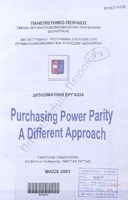Purchasing power parity a different approach

View/
Abstract
Historically, Purchasing Power Parity (henceforth PPP) provides the simplest explanation of long-run exchange rate determination, according to which the equilibrium exchange rate between domestic and foreign currencies equals the ratio between domestic and foreign prices. A few years ago, PPP validity theory seemed like a fairly dull research topic. On the one hand the unavoidable effects of floating exchange rates made it obvious to even its most stubborn defenders that PPP is not a short-run relationship; depreciation or appreciation of a product does not cancel out exchange rate movements on a monthly or even annual basis. On the other hand, there were neither sufficient time spans of floating rate data nor adequate econometric techniques for testing PPP theory as a long-run relationship. Fortunately, things are quite different nowadays and, by means of modern econometric techniques, important results have emerged.


